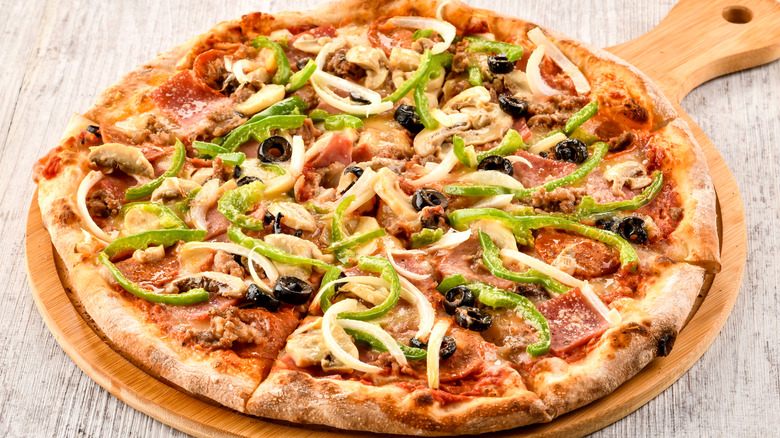One Simple Mistake Can Turn Your Homemade Pizza Into A Complete Disaster
If you're making homemade pizza (which isn't as daunting as it sounds), there are a few things to keep in mind. You'll want to start with a proper dough recipe, put together a deliciously savory tomato sauce, and get the right mozzarella for the job. Now that you have your bases covered, there's the matter of toppings. But one common mistake that trips up ambitious pizza makers is getting the quantity right.
Pizza that's loaded with too many toppings (as delicious as it may sound) can easily spell disaster. Part of the problem is that toppings can affect the structural integrity of the final product. If they're too heavy, the pizza might not bake evenly, leaving some spots of dough less cooked than others (nobody likes gummy dough), and if the pizza is overloaded, each slice will immediately fall apart after being lifted. Some crusts can handle a lot of weight by design, but as a general rule, the restrained hand is the more effective one.
This comes from my experience as a former restaurant pizzamaker. When I first started learning how to build a proper pizza, I basically had that idea that "more is more" (the ol' Midwestern philosophy) until I realized our Neapolitan-style dough just couldn't handle that much. Overloaded pies easily lead to dining disasters, so this is something you'll always need to keep in mind when topping your own.
Certain pizza toppings also emit liquid while baking
The other thing you'll want to keep in mind when customizing your pizza is that most toppings emit liquid while they're being cooked, though to varying degrees. Things like thinly-sliced cured meats put out a slick of oil, so too much can turn your pizza into a greasy mess. And many, if not all, veggies leak water to some extent. Serial offenders include mushrooms, fresh tomatoes, bell peppers, and sometimes onions, depending on whether or not they're cut into large chunks.
If you overtop a pizza with these ingredients, it's all but guaranteed to get soggy right after you cut it — you may even have to knife-and-fork it if things get really bad. This even goes for adding fresh veggies to a frozen pizza prior to baking it. You can mitigate this by pre-cooking the veggies a bit before adding them to the pizza, but then they may come out of the oven a little too shriveled up, which changes the texture of each bite. As you can see, it's a bit of a balancing act.
So, my advice is this: Top your pizza sparingly but with enough that you know you'll crave another bite. Your aim isn't to be overwhelmed by a single slice, but to appreciate the combined topping flavors. That, in turn, will prevent your pizza from becoming a disaster zone, and you'll happily look back at a delicious, satisfying meal rather than a wet, mushy one.

